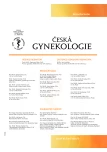Cervical mucus and its role in reproduction
Authors:
K. Crha 1; P. Ventruba 1; J. Žáková 1; M. Ješeta 1,2; R. Pilka 3; J. Vodička 3; I. Crha 1,4
Authors‘ workplace:
Gynekologicko‑porodnická klinika Lékařské fakulty Masarykovy univerzity a FN, Brno, přednosta doc. MUDr. V. Weinberger, Ph. D.
1; Česká zemědělská univerzita, Praha
2; Porodnicko‑gynekologická klinika FN a LF UP, Olomouc, přednosta prof. MUDr. R. Pilka Ph. D.
3; Lékařská fakulta Masarykovy univerzity, Katedra ošetřovatelství a porodní asistence, Brno
4
Published in:
Ceska Gynekol 2020; 85(5): 333-338
Category:
Overview
Objective: Uterine cervix is an important part of female reproductive system. It has a specific structure and function. Disorders of cervix may cause severe reproductive and pregnancy complications. It creates a barrier between intruterine and vaginal environment. Cervical mucus is one of the important factors of correct cercvical function. It udergoes dynamic changes during the menstrual cycle. Latest research brings new knowledge about cellular and molecular biomarkers present in cervical mucus, which may contribute to better diagnosis of human reproduction disorders. Objective of this article is to present contemporary knowledge of the role of cervical mucus in human reproduction.
Design: Review article.
Setting: Department of Obstetrics and Gynecology, Faculty of Medicine, Masaryk university and University Hospital Brno; Department of Obstetrics and Gynecology, University Hospital Faculty of Medicine, Palacky University, Olomouc; Department of Nursing and Midwifery, Faculty of Medicine, Masaryk university and University Hospital Brno.
Methods: PubMed was searched for articles in English indexed until February 2020 with terms of: „cervical mucus“, „sperm cervical mucus intraction“, „cervical mucus composition“, „cervical biomarkers“.
Results: Literary research has summarized contemporary knowledge about the uterine cervix and cervical mucus and their role in human reproduction. Analysis of molecular and cellular biomarkers in cervical mucus can be useful in diagnostics of infertility.
Conclusion: Analysis of cellular and molecular composition of cervical mucus brings new knowledge about its fysiological fuction and possible disorders. It provides information about endometrial activity and receptivity, course of pregnancy and its possible complications such as risk of preterm labour.
Keywords:
cervix – cervical mucus – proteome – cervical biomarkers
Sources
1. Balko, J., Tonar, Z., Varga, I., et al. Memorix histologie. Praha: Triton, 2016, 1. vydání, 529 s.
2. Brandes, M., Hamilton, CJ., de Bruin, JP., et al. The relative contribution of IVF to the total ongoing pregnancy rate in a subfertile cohort. Hum Reprod, 2010, 25, p. 118–126.
3. Crha, I., Ventruba, P., Žáková, J., et al. Děložní mikrobiom jako faktor receptivity endometria. Čes Gynek, 2019, 84(1), s. 49–54.
4. Crha, K., Ventruba, P., Žáková J., et al. Přeměna mezenchymálních a epiteliálních buněk – vliv na funkci a receptivitu endometria. Čes Gynek, 2019, 84(5), s. 371–375.
5. Crha, K., Ventruba, P., Žáková J., et al. The role of uterine microbiome and epithelial-mesenchymal transition in endometrial function. Med J Cell Biol, 2019, 7(3), p. 146–151. doi: 10.2478/acb-2019-0020.
6. Curlin, M., Bursac, D. Cervical mucus: from biochemical structure to clinical implications. Frontiers Biosci, 2013, 5, p. 507–515.
7. Evans, J., Hutchison, J., Lois A., et al. Proteomic insights into endometrial receptivity and embryo-endometrial epithelium interaction for implantation reveal critical determinants of fertility. Proteomics, 2020, 20, p. 1–13. doi: 10.1002/pmic.20190025.
8. Evans, J., Walker, KJ., Bilandzic, M., et al. A novel “embryo-endometrial” adhesion model can potentially predict “receptive” or “non-receptive” endometrium. J Assist Reprod Genet, 2020, 37, p. 5–16. doi: 10.1007/s10815-019-01629-0.
9. Flori, F., Secciani, F., Capone, A., et al. Menstrual cycle-related sialidase activity of the female cervical mucus is associated with exosome-like vesicles. Fertil Steril, 2007, 88, p. 1212–1219.
10. Grande, G., Vincenzoni, F., Milardi, D., et al. Cervical mucus proteome in endometriosis. Clin Proteom, 2017, 14, 7. doi: 10.1186/s12014-017-9142-4.
11. Hwang, LY., Scott, ME., Ma, Y., et al. Higher levels of cervicovaginal inflammatory and regulatory cytokines and chemokines in healthy young women with immature cervical epithelium. J Reprod Immunol, 2011, 88, p. 66–71.
12. Janku, P., Kacerovsky, M., Andrys, C., et al. Cervical fluid pentraxin-3 complicated by preterm prelabor rupture of membranes. Fetal Diag Ther, 2019, 46(6), p. 402–410.
13. Ješeta, M., Crha, T., Žáková, J., et al. Bisfenoly v patologii reprodukce. Čes Gynek, 2019, 84(2), s. 161–165.
14. Menarguez, M., Pastor, LM., Odeblad, E. Morphological characterization of different human cervical mucus types using light and scanning electron microscopy. Hum Reprod, 2003, 18, p. 1782–1789.
15. Papíková, Z., Hudeček, R., Ventruba, P., Szypulová, M. Účinnost dienogestu v terapii klinických symptomů endometriózy rektovaginálního septa. Čes Gynek, 2019, 84(5), s. 331–336.
16. Rob, L., Martan, A., Ventruba, P., et al. Gynekologie, 3. ed. Praha: Galén, 2019, 356 s.
17. Spracklen, CN., Harland, KK., Stegmann, BJ., et al. Cervical surgery for cervical intraepithelial neoplasia and prolonged time to conception of a live birth: a case-control study. BJOG, 2013, 120, p. 960–965.
18. Ulčová-Gallová, Z. Immunological and physicochemical properties of cervical ovulatory mucus. J Reprod Immunol, 2010, 86, p. 115–121.
19. Ulčová-Gallová, Z., Pešek, M., Mukenšnábl, P., et al. Screening of endometrial NK cells in selected infertile patients. First part. Methods and current results. Čes Gynek, 2017, 82(5), s. 366–371.
20. Ulčová-Gallová, Z., Mukenšnábl, P., Haschová, M., et al. NK buňky nejen v endometriu, ale i v ovulačním cervikálním sekretu u žen se sníženou plodností. Čes Gynek, 2019, 84(3), s. 184–189.
21. Vodička, J., Dvořan, M., Smékalová, K., et al. Možnosti přípravy endometria ke kryotransferu. Čes Gynek, 2018, 83(1), s. 24–28.
22. Ventruba, P., Žáková, J., Ješeta, M., et al. Současná témata reprodukční medicíny v České republice. Čes Gynek, 2016, 81(3), s. 234–240.
Labels
Paediatric gynaecology Gynaecology and obstetrics Reproduction medicineArticle was published in
Czech Gynaecology

2020 Issue 5
Most read in this issue
- Clinical significance of routine ultrasound screening of fetal growth restriction in third trimester of pregnancy
- Bilateral salpigektomy as a sterilization method – ovarian cancer prevetion and a rare complication
- Complete hydatidiform mole in perimenopausal patient imitating uterine cancer
- Cervical mucus and its role in reproduction
